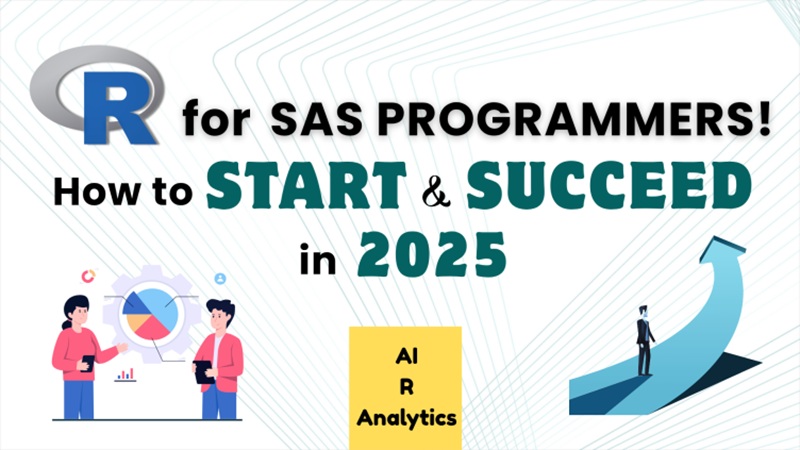R For SAS Programmers: Master R with AI in 2025 For Pharma
19th July 2025, Kathmandu
For years, I was a dedicated SAS programmer. It was the language of my industry—pharmaceuticals—and I was fluent in it. A month-long intensive dive into R several years ago, courtesy of DataCamp, left me with a new skill but a lingering sense of inefficiency. Translating my SAS-ingrained thought process into R’s more fluid, and at times chaotic syntax, was a struggle.
R For SAS Programmers
Fast forward to today, my experience with R is a world apart. I now readily harness a multitude of packages, often without deep-diving into documentation. The secret to this transformation? Artificial intelligence (AI).
The steep learning curve that once intimidated many SAS programmers has been significantly flattened, making 2025 the perfect year to embrace R.
This article will guide you, a fellow SAS programmer, on how to not just start your R journey but to truly succeed, leveraging the incredible advancements that have made this transition easier and more rewarding than ever before.
An Evolving Landscape: Why R Now for SAS Programmers?
The conversation around “R vs. SAS” is not about one replacing the other, but rather about the growing need for bilingual data professionals. While SAS remains the stalwart in regulated environments, particularly for final regulatory submissions, the industry is undeniably shifting.
Industry Trends and Regulatory Acceptance
The demand for R skills is on a steady incline. While the FDA and other regulatory bodies have historically favored SAS due to its validated nature, there’s a growing acceptance of R, especially for exploratory analysis, data visualization, and internal reporting in the pharmaceutical industry. The key is demonstrating the validity of the R packages used, and the open-source community has risen to this challenge with robust documentation and testing. This evolving landscape makes learning R a smart move in 2025.
The Power of Analytics and Visualization
This is where R truly shines. With packages like ggplot2, you can create stunning, publication-quality graphics with a level of customization that is simply unmatched by SAS’s PROC GPLOT. Furthermore, R’s interactive web application framework, Shiny, is a game-changer for clinical trial reporting. Imagine providing stakeholders with a dynamic dashboard where they can explore data in real-time, a far cry from static PDF reports. This visualization capability is a huge draw for SAS programmers moving to R.
Career Advancement
In today’s job market, having both SAS and R on your resume makes you a significantly more attractive candidate. It signals a versatile skillset and a forward-thinking approach to data analysis, opening up more opportunities for SAS programmers in 2025 and beyond.
A New Way of Thinking: Understanding R’s Paradigm
For a SAS programmer, stepping into the world of R can feel like moving to a new country where you recognize some words, but the grammar is entirely different.
Language and Concepts
SAS is a procedural language with a clear, structured syntax. You have your DATA steps for data manipulation and your PROC steps for analysis. R, on the other hand, is an object-oriented and functional programming language. Everything in R is an object, and you apply functions to these objects. This offers immense flexibility but can initially feel less structured than the familiar SAS framework.
The Universe of Packages
In SAS, you have a comprehensive set of built-in procedures. In R, the core language is relatively lean, and its power lies in the thousands of user-contributed packages. Think of packages as specialized toolkits for everything from data manipulation (dplyr, data.table) and visualization (ggplot2) to survival analysis (survival) and creating interactive reports (rmarkdown, Shiny). The Comprehensive R Archive Network (CRAN) is the primary repository for these packages, a vast ecosystem for any R user.
Multiple Paths to the Same Destination
A common source of frustration for SAS programmers is that in R, there are often multiple ways to accomplish the same task. For example, you can filter a data frame using base R syntax, the dplyr package, or the data. table package. This initial “analysis paralysis” can be daunting, but it also offers the flexibility to choose the approach that best suits your style and the specific problem at hand.
A Mindset Shift for the Non-Computer Scientist
Many of us in the pharmaceutical industry come from a statistics or biology background, not computer science. SAS’s straightforward syntax was a gentle introduction to programming. R, with its command-line interface and object-oriented nature, can feel more intimidating. The key is to embrace a more exploratory and iterative mindset. Don’t be afraid to experiment, and remember that with R, the community and now AI are your constant companions.
Charting Your Course: Modern Training Pathways for R in 2025
The good news is that you don’t have to navigate this new terrain alone. The resources for learning R have exploded in recent years.
Massive Open Online Courses (MOOCs)
DataCamp: My journey started here. It offers an interactive, hands-on learning experience that is excellent for beginners.
Coursera: Platforms like Coursera host courses from top universities. Look for specializations like the “Johns Hopkins Data Science: Foundations using R” for a comprehensive curriculum tailored for R programming.
Pharma-Focused Workshops
Keep an eye out for workshops and webinars specifically tailored to the pharmaceutical industry. These can range from a few hours to several months of training and often focus on using R for clinical trial analysis and reporting, providing context that general courses may lack for SAS programmers.
Essential Reading
Books remain a valuable resource. A classic is “R for SAS and SPSS Users” by Robert A. Muenchen, which provides direct comparisons and translation examples, making the transition smoother for SAS programmers.
Essential Tools for Your R Journey: Desktop and Online Environments
Your R code needs a place to live and run. Setting up the right environment is crucial for a smooth learning experience. Here’s a look at the most popular desktop and online tools to help you practice and succeed.
The Gold Standard: RStudio Desktop (now Posit)
For serious R development, RStudio Desktop is the undisputed champion. It’s an Integrated Development Environment (IDE) that has all the tools you will need in your R journey. First, you’ll need to install R itself, and then you’ll install RStudio. For a SAS user, RStudio provides a familiar multi-pane layout for easier navigation.
Hassle-Free Learning: Posit Cloud (formerly RStudio Cloud)
If the idea of installing software feels like a barrier, Posit Cloud is your answer. It’s essentially R and RStudio running in your web browser.
Pros: Zero installation or configuration required. You can access your projects from any computer. It’s perfect for following along with online courses or workshops without worrying about version conflicts.
Cons: The free tier has limitations on project hours and computing power, but it’s more than enough for learning and small projects.
The Notebook Approach: Jupyter and Google Colab
If you’re new to R, starting in a notebook environment such as Jupyter or Google Colab can be beneficial. The cell-based interface may feel unfamiliar at first, but most learners acclimate quickly. Notebooks let you run bite-sized chunks of code, view the output instantly, and mix narrative notes with plots and tables—all of which makes them perfect for the rapid, trial-and-error style that characterizes the early learning phase.
Jupyter Notebooks/JupyterLab: While famous in the Python world, Jupyter has excellent support for R via a component called the IRkernel. This allows you to create elegant, shareable reports and analyses, making it a great alternative to Markdown for some use cases.
Google Colab: Similar to Jupyter, Google’s free Colab environment also supports an R kernel. A simple settings change is all it takes to switch from Python to R, giving you another powerful, free, cloud-based platform for practice.
For Quick Tests: Online R Compilers
Sometimes you just want to test a single command or a small snippet of code. Numerous websites offer simple online R compilers or “fiddles” where you can type and run code instantly. They are great for quick sanity checks or experimenting with a function you’ve just read about.
By choosing the right tool for your needs—RStudio Desktop for dedicated work, Posit Cloud for easy onboarding, and notebooks for integrated reporting—you can create an effective and enjoyable environment for mastering R.
The Game Changer: AI as Your R Co-Pilot in 2025
This brings me back to my journey. The reason I can now navigate the vast R ecosystem with confidence is the advent of powerful AI tools. This is the single biggest change that has made learning and using R more accessible than ever before for SAS programmers.
ChatGPT: Your Interactive R Tutor
Gone are the days of endlessly scrolling through documentation or Stack Overflow. With ChatGPT, you can:
Translate SAS to R: Simply paste your SAS code and ask for the R equivalent. It’s not always a perfect one-to-one translation, but it provides an incredible starting point and helps you understand the R way of thinking.
Explain R Code: Encounter a complex line of R code? Ask ChatGPT to break it down for you in plain English.
Generate Code from Natural Language: This is where the magic truly happens. You can describe the analysis you want to perform—”I want to create a Kaplan-Meier plot for survival by treatment group”—and ChatGPT will generate the ggplot2 and survival code for you.
Debug Your Code: Getting an error message you don’t understand? Paste the error and your code, and ChatGPT can often identify the problem and suggest a solution.
Automated Code Translation and Interactive Help
Beyond general-purpose AI like ChatGPT, we are seeing the rise of more specialized tools and IDE integrations. GitHub Copilot, for instance, provides real-time code suggestions as you type in your R script. These AI tools are revolutionizing R programming for everyone, especially those transitioning from SAS.
The role of AI is not to replace your learning but to accelerate it. It removes the friction points that used to cause so much frustration. Instead of getting stuck on a syntax error for hours, you can get instant help and focus on the bigger picture of your analysis.
The days of viewing R as an insurmountable challenge for a seasoned SAS programmer are over. With a wealth of training resources and the revolutionary assistance of AI, 2025 is the year to expand your skills, embrace a new way of thinking about data, and unlock the immense power and flexibility that R has to offer. Your journey starts now, and with the right tools and mindset, you are destined to succeed.
For more: R for SAS Programmers







